Porcelain Insulator News
by Elton Gish, NIA #41
Reprinted from "Crown Jewels of the Wire", September 1990, page 15
Fred Locke, as many of you know, is considered the "father of porcelain
insulators". He developed the first high voltage porcelain insulators
during a time when transmission of electrical power was in its infancy. voltages
used in the transmission of power progressed rapidly from 10,000 to 60,000 volts
during the period from 1895 to 1903. This was Fred's heyday; the only period
which Fred was directly involved in the design, manufacture, and sale of
porcelain insulators. While he sold millions of porcelain insulators during that
time, only those made from late 1898 until 1903 were produced in his factory.
All of that production was of rather poor quality, no doubt the result of highly
competitive pricing, the rapid pace of power line construction, and ever
increasing line voltages.
Insulators made with an eave gutter and rain spout
were the first multipart insulators. They were designed by Fred Locke in early
1900 for use on the 40,000 to 60,000 volt Bay Counties Power Co. (a double
circuit 152 miles long from Colgate to Oakland) and Standard Electric Company
(219 miles long from Electra to Oakland and San Francisco) lines.
CLASSIC EAVE AND SPOUT AND SPOUT INSULATORS MANUFACTURED BY FRED
M. LOCKE
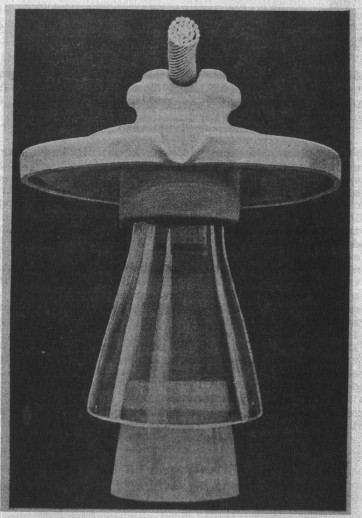
This is M-2795 as used on the Bay Counties and Standard Electric Companies
line in northern California from 1900 until 1904.
This map shows the routes of the power lines which used M-2795 as installed
by the Bay Counties and Standard Electric Companies (The Electrical Age dated
October, 1904).
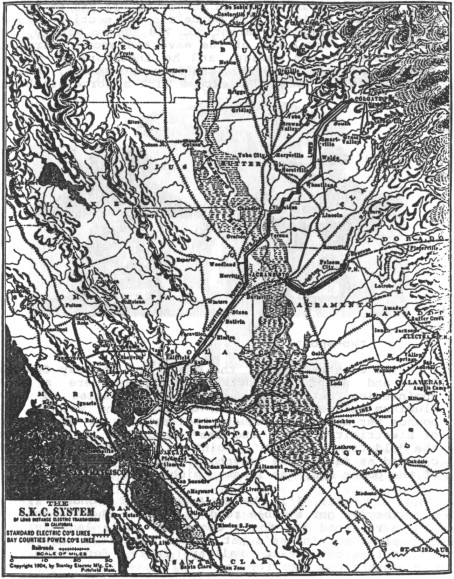
Those two
systems covered 371 miles in northern California. Many tens of thousands of M-2795, which had a single
spout, were installed. This insulator used a glass base in combination with a
porcelain top. The purpose of the eave gutter and rain spout was to direct
rainwater away from the crossarm to prevent wetting of the underside of the
insulator. A mixture of sulfur and sand was used as cement.
Fred was granted
design patent No. 32,741 on May 29, 1900 for the design of the porcelain top
section. He was later granted utility patent No. 728,805 on May 19, 1903
covering the novel use of the eave and spout. Fred was very proud of his design,
and he incorporated it into several styles: M-2335 (the rare two-spout), M-2795,
M-2796 (similar to M-2795 except with a porcelain base), and M-2785.
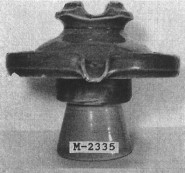 |
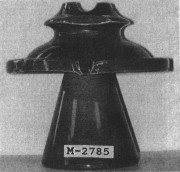 |
| two-spouts |
The construction of the lines for the Bay Counties Power and Standard
Electric Companies were a great engineering feat. The main line consisted of
three aluminum cables 7/8 inch in diameter and weighed 2404 pounds per mile. An
August, 1901 article in "The Journal of Electricity, Power and Gas"
described the line from the "old-time" lineman's point of view. After
he had climbed as far as the telephone arm, looked up at the top of the power
arm, the lineman might have exclaimed:
"Well, I'll be switched! I wonder if they've got a cable road up there.
They've got a railroad tie for a crossarm, table legs for pins, a Chinaman's hat
for an insulator, and a full-grown street railway cable for wire. That's too
much for me!"
The M-2795 insulator was very unusual and entirely Fred Locke's design.
Fred's stated purpose of design can be found in an article written by him in the
November, 1901 issue of "The Journal of Electricity, Power and Gas". He believed that the higher voltages presented a problem with
insidious surface leakage that could not be stopped with longer leakage paths
provided by a multiple of petticoats. The insulator should, he thought, not be
designed with petticoats to lengthen the leakage path, but rather it should be
designed with a large arcing distance from conductor cable to pin. He stated his
best designs were the new "Victor" insulators where "the top is
extended laterally, or in an umbrella shape, and the center is extended down
around the support, also preventing arcing to the pin. All other surface is cut
out."
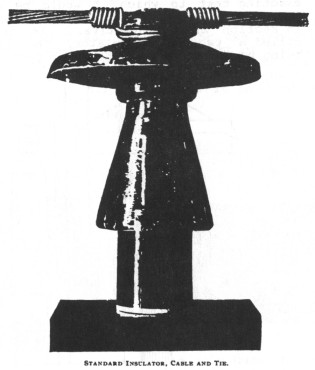
This design proved to be flawed and resulted in numerous problems,
particularly in areas of salt fog. One account describes problems with
mysterious grass fires along the Bay Counties line. It was discovered that the
insulators were heating up from the surface leakage to such an extent that the
sulfur cement was melting, catching on fire, and dropping to the ground igniting
the grass around the pole. The insulators proved to be of marginal service as
long as conditions were dry, and they were quickly replaced in salt fog areas
with larger insulators. In 1904, the line was completely rebuilt with M-3725 and
M-4325 made by Locke.
An interesting description of M-2795 can be found in I the August, 1901 issue
of "The Journal of Electricity, Power and Gas":
"Without tiring you with the details of the development of the insulator
that the Standard Electric company is using, I will state briefly that at the
time we adopted it there was nothing on the market that would anywhere near meet
our requirements, hence it was not until after many months of cut and try
methods had passed before we obtained an insulator that would stand the exacting
test to which it would be subjected. (The figure below] shows the Standard
insulator in section and perspective. It is what is called a two-part insulator,
the upper part being of porcelain and the lower part of glass.
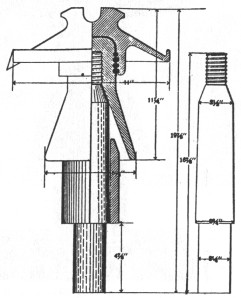
There are several reasons why a combination insulator was decided upon.
First, the dielectric strength of the glass is greater than an equal thickness
of porcelain, while, on the other hand, moisture clings less readily to the
porcelain. It was also found that a much cheaper insulator could be made in this
way than making it either wholly of glass or of porcelain. As a matter of
fact, the insulator as designed could not be made of glass in one piece. The two
parts of the insulator are cemented together with a cement composed of sulfur
and sharp sand in about equal parts. After being cemented together, every
insulator is subjected to a test of 120,000 volts for period of five minutes, and if any insulator shows sign of weakness it is
rejected.
On the base of the pin is used a porcelain sleeve 5 inches long, which
rests upon the crossarm and projects up beneath the glass petticoat. The object
of this porcelain sleeve is to protect the pin in the event of an arc tending to
strike from the eave on the insulator to the base of the pin. It also protects
the pin from weathering."
The most common eave and spout insulator is M-2795, then M-2796, M-2785 and M-2335 being the rarest. Only two M-2335 are known. There is a report of 1 or 2
others that I have been trying to verify. Another one exists with a glass base,
but the crown has been cut off. One more exists that is all white, but it has
not made it into collector's hands.
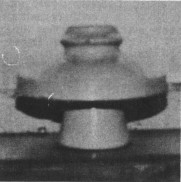
All white M-2335. |
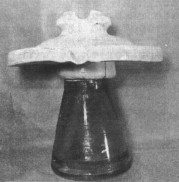
The only known M-2795 with white porcelain
top. |
There are perhaps 20 M-2785's, maybe more. These are very
hard to find available. It seems that they stay in collections for a long time.
M-2796 is closely related to M-2795 in that they used the same top. All of these
that I have seen were recently (past 10-20 years) cemented with Portland cement.
M-2795 was not originally cemented with Portland cement, but rather with sulfur,
and I suspect that M-2796 was originally cemented with sulfur as well. The great
majority of M-2795's were used on the Bay Counties and Standard Electric lines.
The great number of failures on those lines and the newly developed three-part
styles marked the rapid death (by 1902) of this eave and spout design. The flat
top was an efficient collector of dirt, the bottom skirt was easily wetted in a
rain, and the spout was of no benefit. The leakage path was too short for 40,000 volt service in all but very dry environs. It was a failed design
from the beginning.
I suspect that most of the M-2796's are really tops from the
Bay Counties and Standard Electric lines since these were so readily available
back in the late 1960's when most were found laying around separated from their
broken glass bases. The porcelain bases evidently surfaced from other lines,
but probably few whole M-2796's were found as evidenced by no specimens have
been reported with the original cement. Maybe the ground was rocky, insulators
dropped naturally top first, or poles fell over breaking the tops first. I have
seen porcelain skirts available, so it is easy to put these with available
tops of M-2795's. My first M-2796 was purchased in two pieces and later
cemented.
There is a variety of markings to be found on the eave and spout
insulators. M-2785 is only found with Fred Locke marking #6-1. M-2796 is found
with marking #4-1, but other markings as may be found on M-2795 surely exist.
Markings on M-2795 are: #1-5, #4-1, $4-2, and #6-2. Each of the two specimens of
M-2335 have different markings: #4-1 and #4-3. The earliest manufacturing date
recorded for the eave and spout insulators is "NOV 24 1900" and the
latest date that I have seen is "NOV 29 1901". Most specimens do have
a manufacturing date except for those with the #1-5 marking. The only white
M-2795 is dated "DEC 7 1900" just two days later than a tan one with
the same marking (#4-1).
Values of M-2796's are probably about equal to M-2795's
with the exception that most collectors seem to prefer the glass bottom. Glass
collectors would buy a M-2795, but more often would pass on the M-2796. So, to a
porcelain collector the values are probably the same, but overall the value
would be less than M-2795. I would guess a value of $125-150 for a good one with
the higher value for one with a pretty glaze and original sulfur cement. Mint
specimens do not exist since the thin, outside edge under the porcelain skirt,
and the spout are very brittle. All of these spouted styles are some of my
favorites particularly M-2795 and M-2335.
The value of M-2785 is probably
$150-175. Value for M-2335 is probably in the range of $300-400. Rarity in
porcelain does not necessarily command great values as does rarity in glass. Few
collectors, too, are aware of the rarity available in porcelain. If you are
interested in putting together a fine collection of uncommon to rare insulators
for a bargain price, porcelain insulators are the hidden opportunity. But, do
not wait too long. Many are becoming interested in porcelain since glass
prices so high.
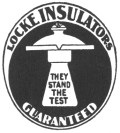
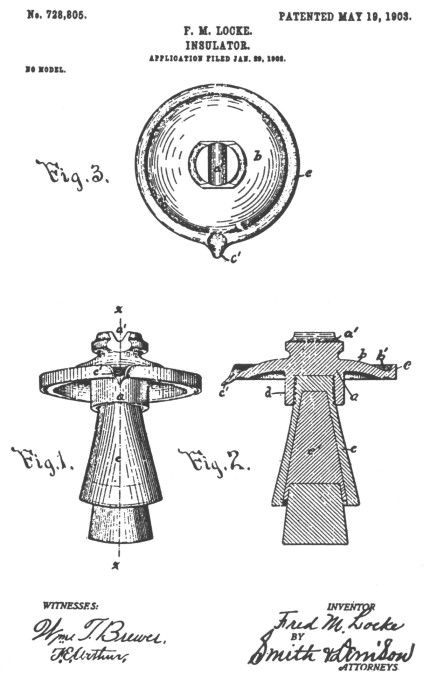
Large Image (115 Kb)
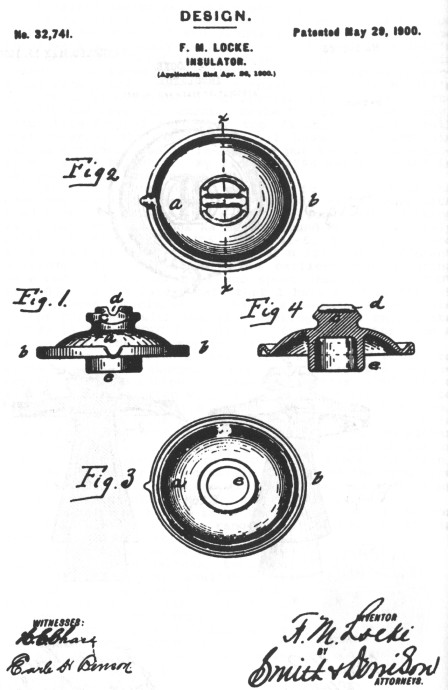
Large Image (123 Kb)
| 